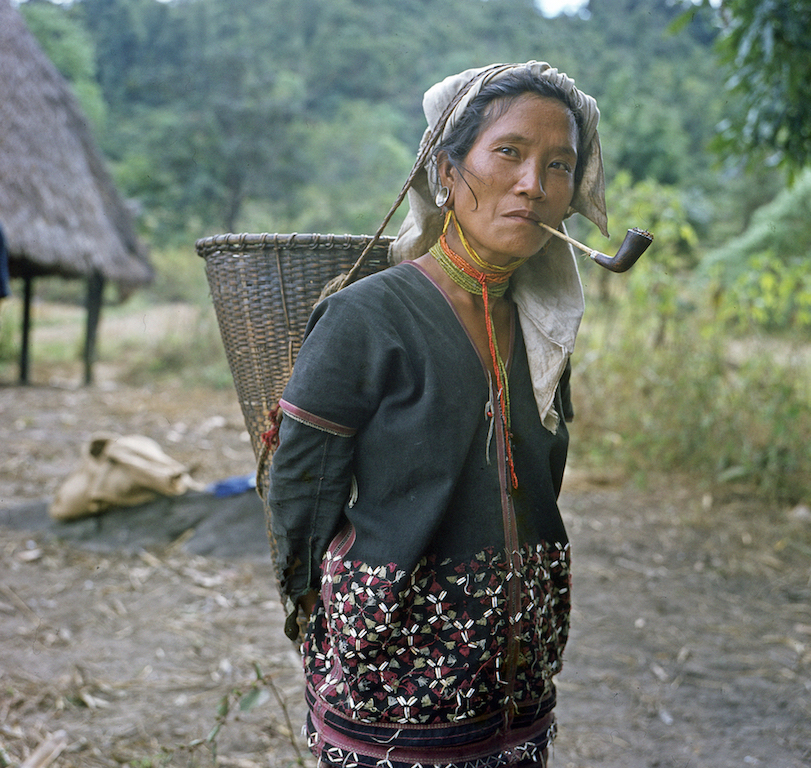 A Karen women in northern Thailand, along the border with Myanmar/Burma. Photograph by Dries Touw, 1965.
A Karen women in northern Thailand, along the border with Myanmar/Burma. Photograph by Dries Touw, 1965.
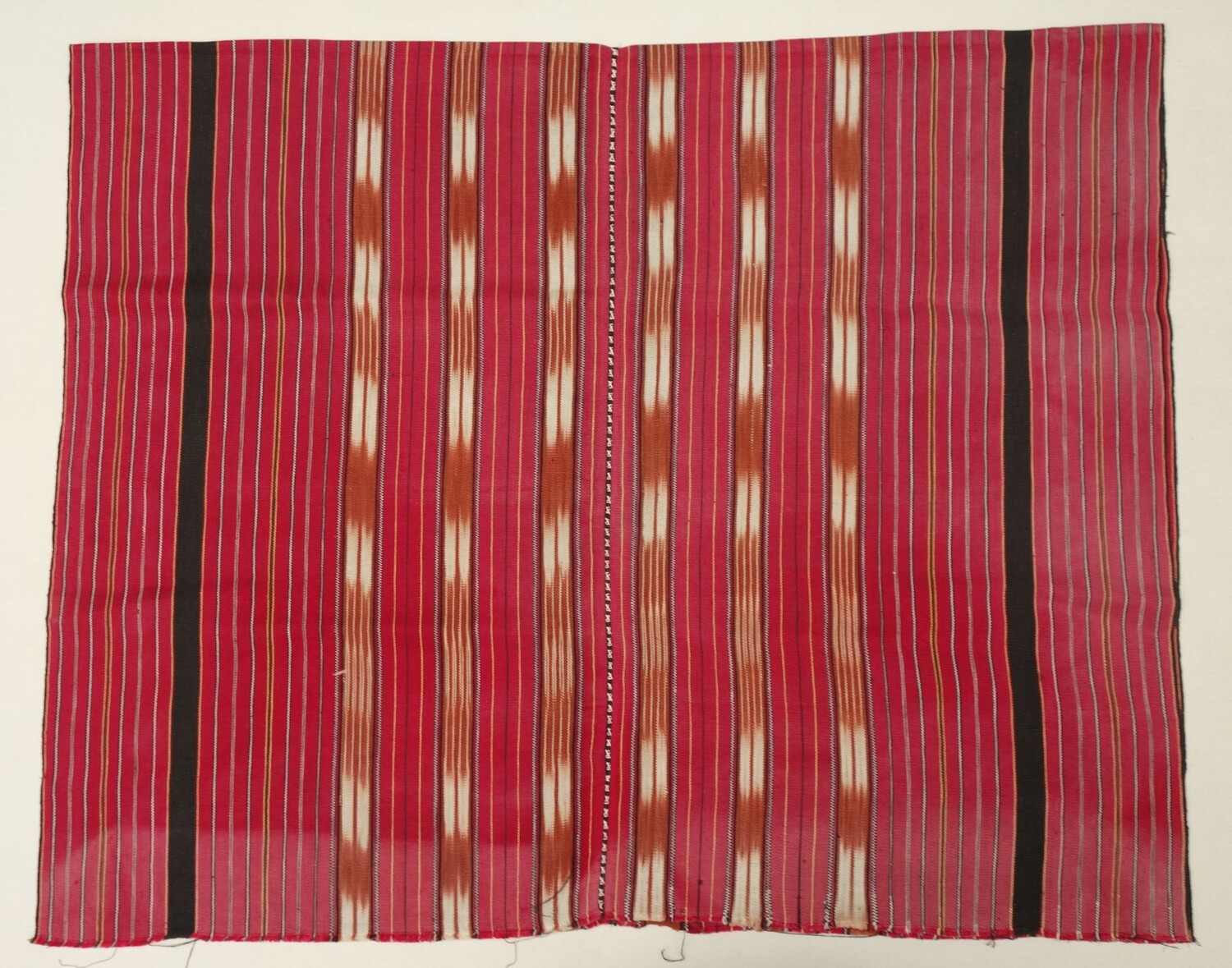 Skirt made from a hand woven, hand dyed (ikat), and hand embroidered cloth. Purchased in 1965 in Thailand from among the Karen (TRC 2023.0189).A few weeks ago we were approached by Ria Snoek, Leiderdorp, about an outfit for a married Karen woman living in Thailand, which was originally acquired by her husband, Dries Touw (1935-2021), a bryologist (a specialist in mosses).
Skirt made from a hand woven, hand dyed (ikat), and hand embroidered cloth. Purchased in 1965 in Thailand from among the Karen (TRC 2023.0189).A few weeks ago we were approached by Ria Snoek, Leiderdorp, about an outfit for a married Karen woman living in Thailand, which was originally acquired by her husband, Dries Touw (1935-2021), a bryologist (a specialist in mosses).
The Karen are an indigenous ethnic group from eastern Myanmar (Burma) and western Thailand. A complete outfit is always welcome, but details emerged that make the story of this donation even more interesting.
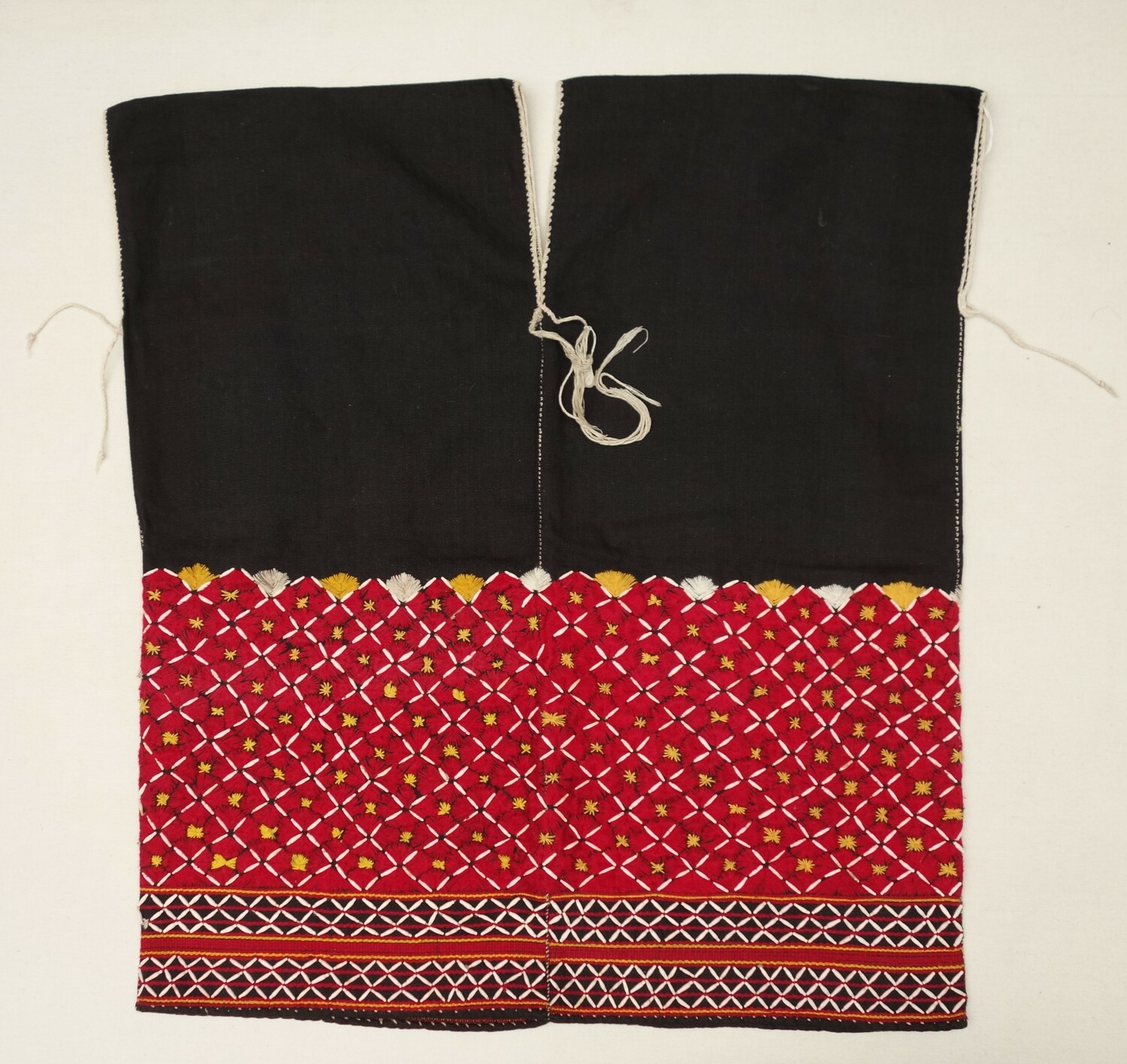 Cotton, hand embroidered top from among the Karen, Myanmar/Thailand, 1965 (TRC 2023.0187).The outfit consists of a top (hse: TRC 2023.0187), a skirt (ni; TRC 2023.0189), a head cloth (hko peu or hko peu ki; TRC 2023.0190) and a shoulder bag (hetu; TRC 2023.0188). The top is made from two lengths of black, hand woven cloth sewn together and then decorated with squares and stars in satin stitch, as well as applied Job’s Tears seeds (Coix family; bwe).
Cotton, hand embroidered top from among the Karen, Myanmar/Thailand, 1965 (TRC 2023.0187).The outfit consists of a top (hse: TRC 2023.0187), a skirt (ni; TRC 2023.0189), a head cloth (hko peu or hko peu ki; TRC 2023.0190) and a shoulder bag (hetu; TRC 2023.0188). The top is made from two lengths of black, hand woven cloth sewn together and then decorated with squares and stars in satin stitch, as well as applied Job’s Tears seeds (Coix family; bwe).
The cloth of the skirt is made from a long strip of hand spun and woven cotton cloth with very decorative ends (u) worked in red supplementary wefts that form small, repeating geometric motifs and long fringes. The skirt is decorated with narrow strips and broader bands with ikat blobs in white and a brownish red.
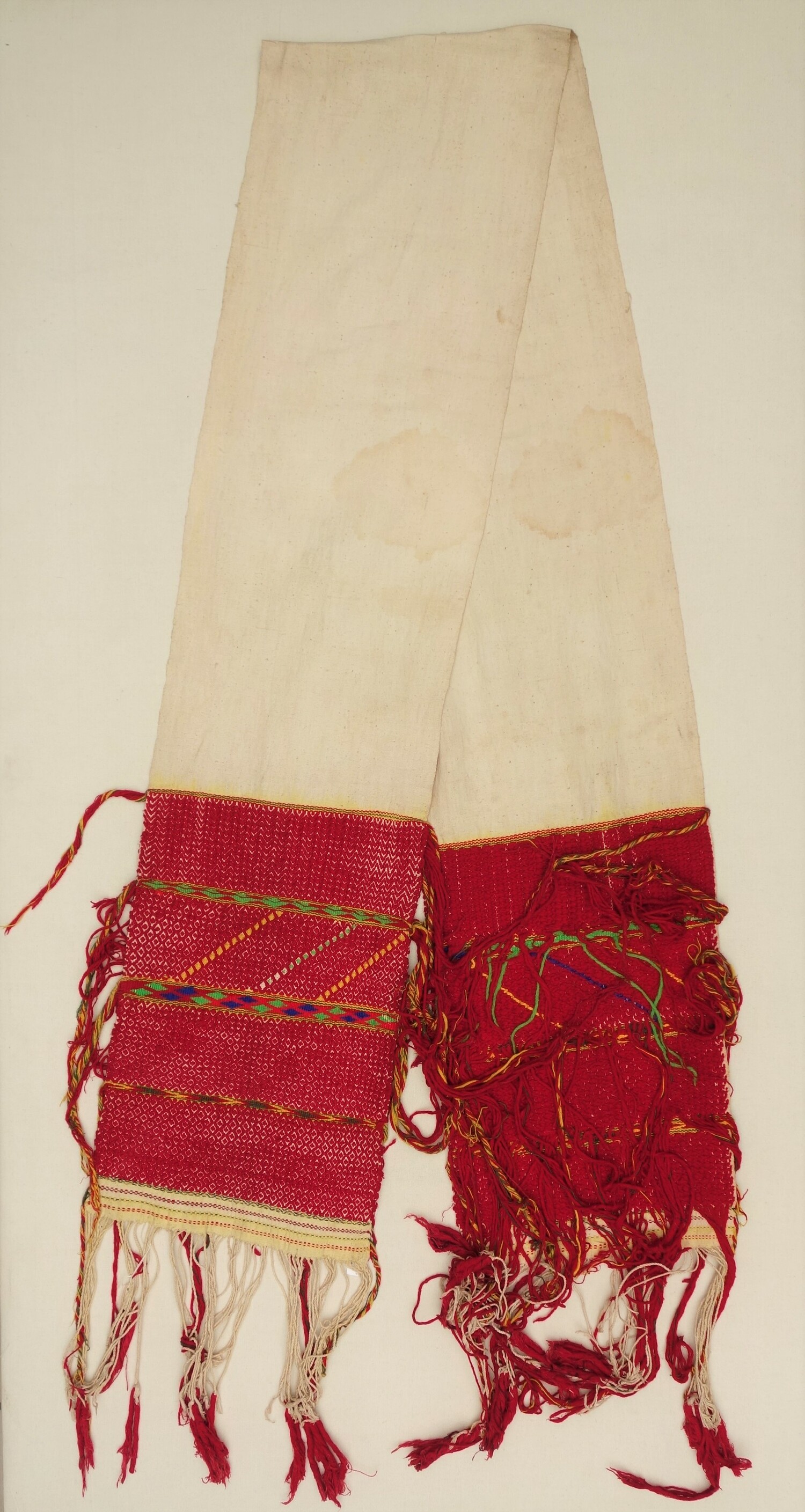 Cotton, women's headcloth from among the Karen, Mynmar/Thailand, 1965 (TRC 2023.0190).The head cloth is made from hand spun and hand woven cotton cloth with transverse ends that are densily decorated with woven patterns of zig-zags, diamond trellis work with dots and diamonds (tapestry weave) in mainly red with blue, green and yellow details. The cloth ends are finished with long white (warp) fringes ending in red tassels.
Cotton, women's headcloth from among the Karen, Mynmar/Thailand, 1965 (TRC 2023.0190).The head cloth is made from hand spun and hand woven cotton cloth with transverse ends that are densily decorated with woven patterns of zig-zags, diamond trellis work with dots and diamonds (tapestry weave) in mainly red with blue, green and yellow details. The cloth ends are finished with long white (warp) fringes ending in red tassels.
And finally the bag is made up of three strips of hand woven, black cotton cloth, which are sewn vertically together using a form of block stitch. The strips are decorated with narrow stripes in red, yellow and white on a black ground. The lower ends of the bag are decorated with stripes and tassels in yellow, blue and red
The outfit is characteristic for various groups of Karen women. Many of the Karen originate in Myanmar (Burma) and became refugees in Thailand following the start of the Karen conflict in Myanmar that has been ongoing since 1949.
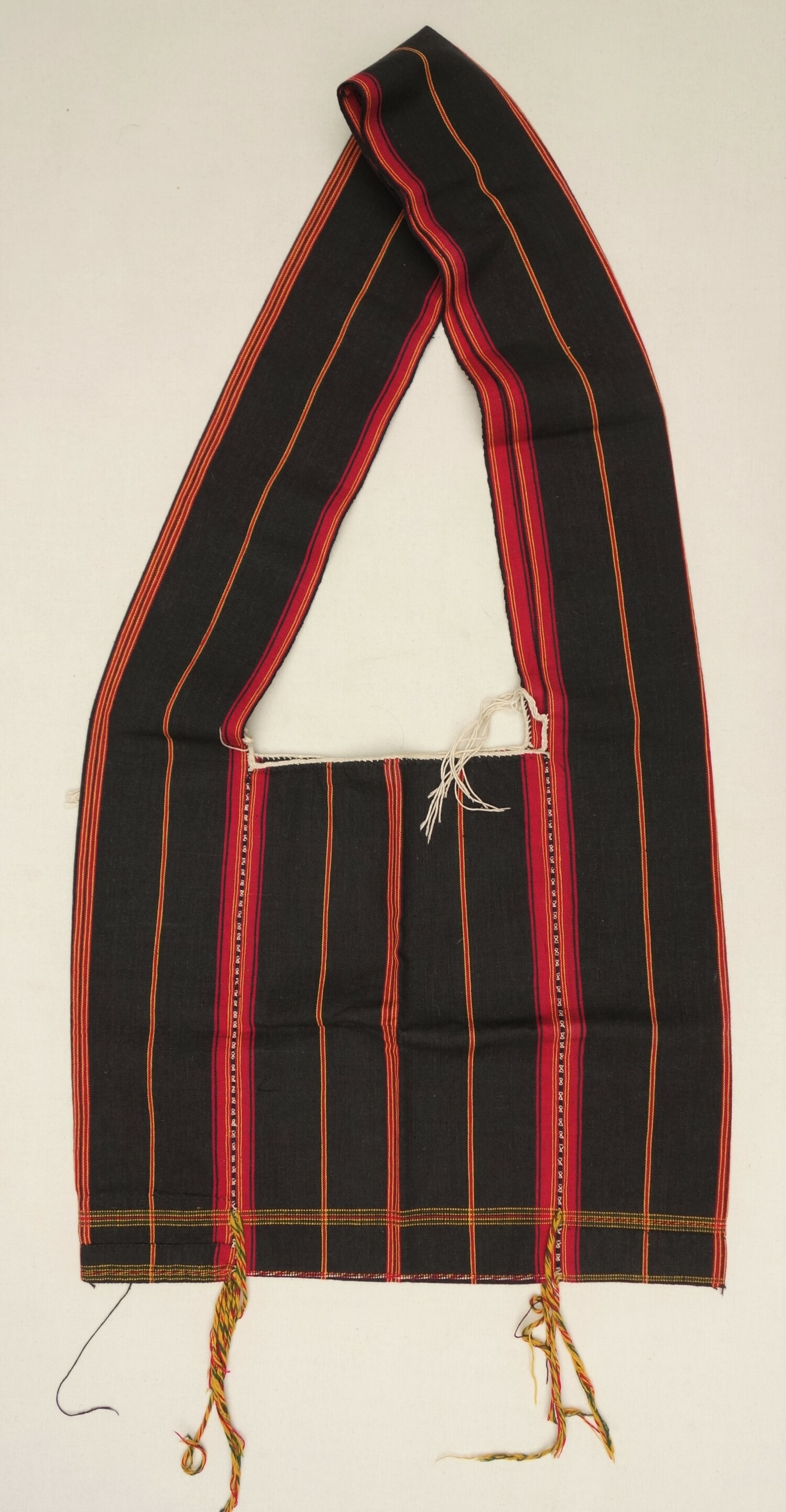 Hand woven, hand embroidered bag from among the Karen, Myanmar/Thailand, 1965 (TRC 2023.0188).According to various entries in Dries Touw’s expedition diary the Karen outfit now in the TRC Collection was bought on 21 December 1965 in the village of Sap Aep, Thailand:
Hand woven, hand embroidered bag from among the Karen, Myanmar/Thailand, 1965 (TRC 2023.0188).According to various entries in Dries Touw’s expedition diary the Karen outfit now in the TRC Collection was bought on 21 December 1965 in the village of Sap Aep, Thailand:
Dinsdag 21 december:
Terug naar Sop Aep ‘s Middags gingen we naar het dorp, waar souvenirs kochten en fotografeerden. Wat het eerst opviel waren de daken van de huizen op palen, waarop grote, leerachtige bladen van de woudreus Dipterocarpus als dakpannen fungeerden. …… Ik deelde chio’s uit en Hollandse snoepjes, en kocht een draagtas, een wikkelrok, een bijpassende hoofddoek en een kruisboog voor grote jongens. Meisjes moesten hier na hun kindertijd spierwitte gewaden en een witte hoofddoek dragen.
Getrouwde vrouwen droegen een rood gebandeerde wikkelrok en een zwart, prachtig geborduurd jak. Op de onderste helft waren elkaar kruisende rijen jobstranen genaaid, de spierwitte en steenharde zaden van het gras Coix lacrima-jobi. Die zaden werden op veel plaatsen in de tropen gekweekt voor versieringen. Alle stof werd ter plekke geverfd en geweven op de ons al bekende, aan het lichaam van de weefster bevestigde weefgetouwen. Mannen droegen onopvallende kleding.
Translation:
Tuesday December 21:
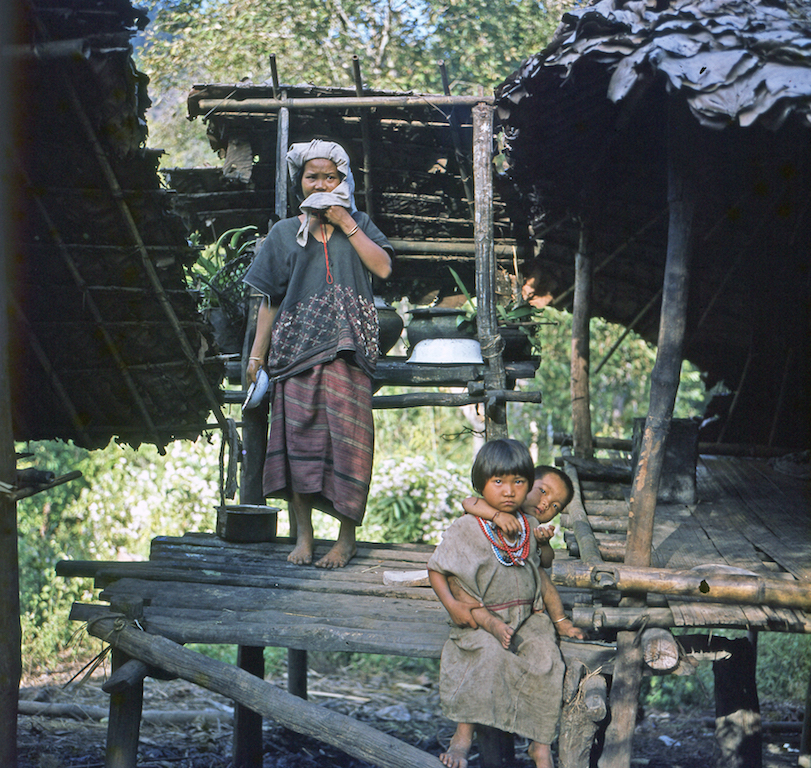 Karen woman and children, northern Thailand along Myanmar/Burma border, 1965. Photograph by Dries Touw, 1965.Back to Sop Aep. In the afternoon we went to the village, where we bought souvenirs and took pictures. The first thing to notice were the roofs of the houses on stilts, on which large, leathery blades of the forest giant dipterocarpus acted as roof tiles. …… I handed out chios and Dutch sweets, and bought a shoulder bag, a wrap skirt, a matching head cloth and a crossbow for big boys. Girls here had to wear bright white robes and a white headscarf after their childhood.
Karen woman and children, northern Thailand along Myanmar/Burma border, 1965. Photograph by Dries Touw, 1965.Back to Sop Aep. In the afternoon we went to the village, where we bought souvenirs and took pictures. The first thing to notice were the roofs of the houses on stilts, on which large, leathery blades of the forest giant dipterocarpus acted as roof tiles. …… I handed out chios and Dutch sweets, and bought a shoulder bag, a wrap skirt, a matching head cloth and a crossbow for big boys. Girls here had to wear bright white robes and a white headscarf after their childhood.
Married women wore a red banded wrap skirt and a black, beautifully embroidered jacket. On the bottom half were sewn intersecting rows of Job's Tears, the snow-white and stone-hard seeds of the grass Coix lacrima-jobi. Those seeds were grown for decoration in many places in the tropics. All cloth was dyed on the spot and woven on the looms already known to us, attached to the body of the weaver. Men wore inconspicuous clothing.
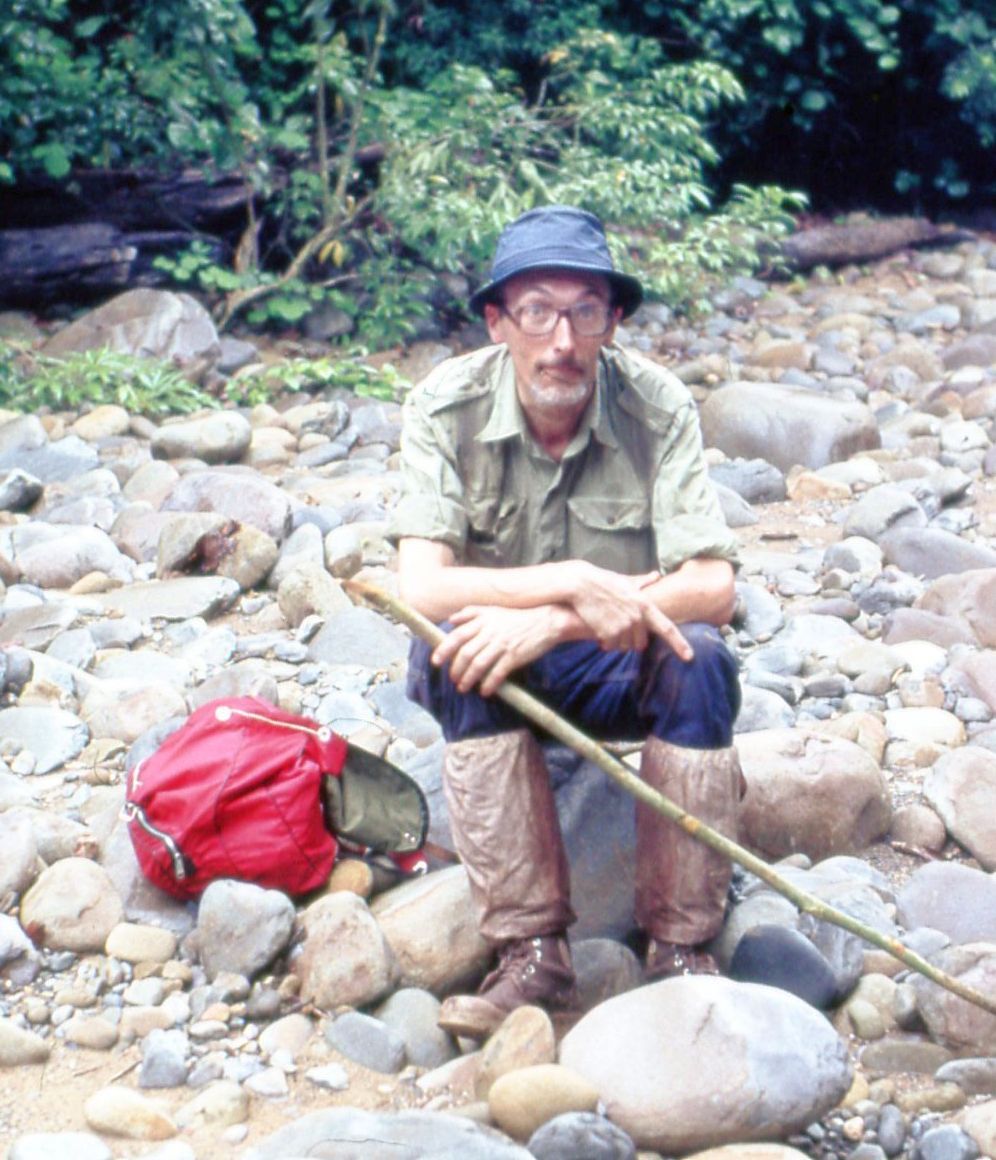 Dries Touw, in the jungle along the Thailand/Myanmar border, 1965.It was noted in the extract from Touw’s diary that he took photographs, and the TRC has been given scans of various relevant images. These include Karen men and women in various forms of regional dress, as well as one with a Karen woman weaving using a back strap loom, of the type mentioned in the diary.
Dries Touw, in the jungle along the Thailand/Myanmar border, 1965.It was noted in the extract from Touw’s diary that he took photographs, and the TRC has been given scans of various relevant images. These include Karen men and women in various forms of regional dress, as well as one with a Karen woman weaving using a back strap loom, of the type mentioned in the diary.
Gillian Vogelsang-Eastwood, 25 February 2023










